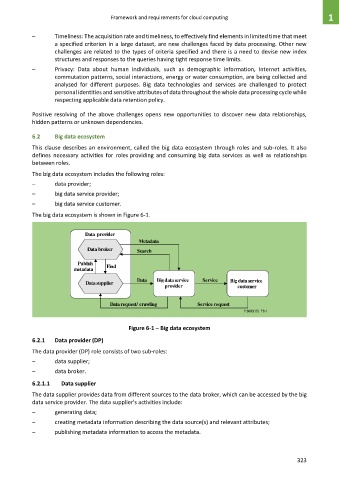Page 331 - Cloud computing: From paradigm to operation
P. 331
Framework and requirements for cloud computing 1
– Timeliness: The acquisition rate and timeliness, to effectively find elements in limited time that meet
a specified criterion in a large dataset, are new challenges faced by data processing. Other new
challenges are related to the types of criteria specified and there is a need to devise new index
structures and responses to the queries having tight response time limits.
– Privacy: Data about human individuals, such as demographic information, Internet activities,
commutation patterns, social interactions, energy or water consumption, are being collected and
analysed for different purposes. Big data technologies and services are challenged to protect
personal identities and sensitive attributes of data throughout the whole data processing cycle while
respecting applicable data retention policy.
Positive resolving of the above challenges opens new opportunities to discover new data relationships,
hidden patterns or unknown dependencies.
6.2 Big data ecosystem
This clause describes an environment, called the big data ecosystem through roles and sub-roles. It also
defines necessary activities for roles providing and consuming big data services as well as relationships
between roles.
The big data ecosystem includes the following roles:
– data provider;
– big data service provider;
– big data service customer.
The big data ecosystem is shown in Figure 6-1.
Data provider
Metadata
Data broker Search
Publish
metadata Find
Data Big data service Service Big data service
Data supplier
provider customer
Data request/ rawlingc Service request
Y.3600(15)_F6-1
Figure 6-1 – Big data ecosystem
6.2.1 Data provider (DP)
The data provider (DP) role consists of two sub-roles:
– data supplier;
– data broker.
6.2.1.1 Data supplier
The data supplier provides data from different sources to the data broker, which can be accessed by the big
data service provider. The data supplier's activities include:
– generating data;
– creating metadata information describing the data source(s) and relevant attributes;
– publishing metadata information to access the metadata.
323

